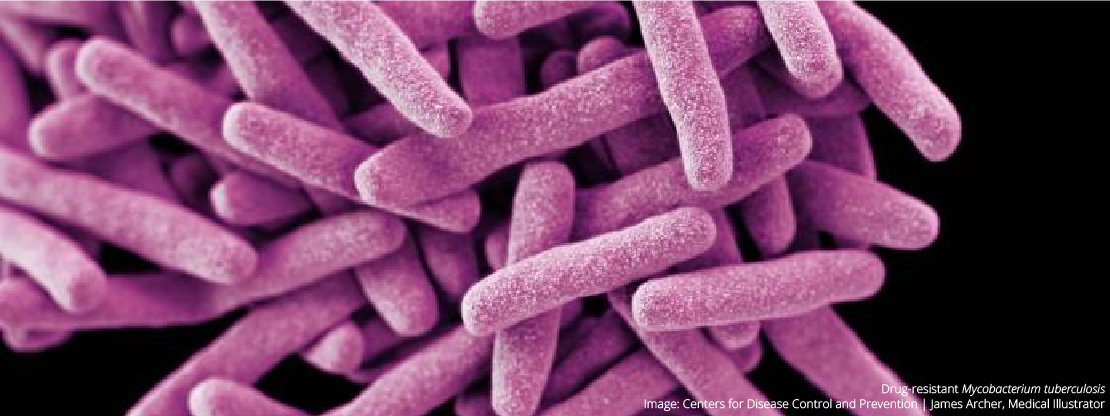Today is World Tuberculosis Day. Here’s what you need to know.
March 23, 2021

On March 24, 1882, German physician Dr. Robert Koch announced that he had identified the bacterium that causes tuberculosis (TB), a deadly disease that at the time was responsible for the deaths of one in seven people in the U.S. and Europe.[1]
His discovery provided hope for a world seeking answers to a feared scourge that, despite vast improvements in medical care and public health, still infects millions around the world today.
World Tuberculosis Day marks Dr. Koch’s discovery and serves as an important reminder that there still is much work to be done.[1]
What is tuberculosis?
Tuberculosis is a disease that primarily attacks the lungs but can affect other organs such as the kidneys and the brain.
It is caused by infection with a bacterium called Mycobacterium tuberculosis, which is spread from person to person through airborne particles. TB most frequently spreads between people who spend time together, such as families. Once in the lungs, it multiplies and does one of two things:
- Stays in the body without causing symptoms, a condition called latent TB
- Actively causes illness, a condition called TB disease [2,3]
People with latent TB may never become sick, or they may fall ill years after infection. They also are not able to spread the bacteria.[3]
People with active TB can become very ill, exhibiting symptoms such as a severe cough, chest pain, coughing up blood or phlegm, weight loss, fever, chills, loss of appetite and night sweats. Those with active cases of TB can spread the bacteria.[3]
For more information on the ways TB is and isn’t spread, please visit the U.S. Centers for Disease Control and Prevention website.
According to estimates, Mycobacterium tuberculosis may have existed for the last 3 million years.[1]
The name “tuberculosis” was coined in 1834 by Johann Schonlein. Before then, it had many names, including:
- Consumption (1800s)
- Captain of all these men of death (1800s)
- The white plague (1700s)
- Phthisis (ancient Greece)
- Tabes (ancient Rome)
- Schachepheth (ancient Hebrew)[1]
Can latent TB become active TB?
Yes. While many people with latent TB do not ever develop active TB disease, certain groups of people are at higher risk of moving from a latent to active infection. This occurs because the body’s natural defenses — the immune system — can no longer keep the TB bacteria in check. According to the CDC, high risk groups include:
- Older people, young children and babies
- People with weak immune systems due to other diseases
- People with HIV
- People whose TB infection was not properly treated in the past
- People who inject illicit drugs[3,4]
For people with latent TB, getting treatment to prevent TB disease is important (preventing active disease also helps limit the spread of the bacteria). For those with active TB, treatment is critical to prevent spread of the disease and to help them return to good health.[3]
TB is treated with various medications over several months. For more information on how TB is treated, please visit the CDC website here.
How many people have TB?
The CDC reports that, in 2019, the U.S. had 8,916 active TB infections, with up to 13 million people living with latent infections. These numbers represent an 89.5% decrease in TB cases and a 95% decrease in TB incidence rate (or new cases) since 1953. Overall, the U.S. has one of the lowest TB rates in the world.[5]
Globally, however, TB is one of the top 10 causes of death and a leading cause of death from a single infectious agent, according to the World Health Organization. In 2019, an estimated 10 million people were sickened by TB.[6]
What is VAI doing to help?
To understand how to best combat TB, we need to pinpoint and understand key weaknesses of the disease-causing bacteria. VAI’s Dr. Huilin Li and his lab are tackling one such vulnerability: the Pup-proteasome system, which the bacteria use to fend off attacks by the body’s immune system. Pup-protease also helps the bacteria survive in immune cells, where it becomes latent.
Using the Institute’s cryo-electron microscope (cryo-EM), a powerful technology that magnifies that smallest parts of life with incredible clarity, Li and his team are working to visualize the bacterial Pup-proteasome system. Creating detailed blueprints are big steps toward the development of anti-TB drugs that target the system.
To this end, Li and his colleagues are researching and developing several promising compounds that disable the bacterial Pup-proteasome system while sparing the host’s own proteasome system (this in important because our own proteosome systems help recycle old and damaged proteins, which is needed for healthy function).
“Although humanity has made great progress in our fight against TB, there still is much work to be done,” Li said. “A major difficulty in combating TB is the latency and the associated development of multi-drug resistance. We’re hopeful that our studies into this target will one day lead to therapies that kill latent TB bacteria.”
Learn more about Dr. Li’s work by visiting his lab website here. Get more information about TB by visiting the CDC website here.
Research reported in this publication was supported by the National Institute of Allergy and Infectious Diseases of the National Institutes of Health under award no. R01AI070285 (Li). The content is solely the responsibility of the authors and does not necessarily represent the official views of the National Institutes of Health.
Sources
[1]World TB Day 2021. Centers for Disease Control and Prevention. Accessed March 11, 2021. https://www.cdc.gov/tb/worldtbday/history.htm
[2]Treatment for TB disease. Centers for Disease Control and Prevention. Accessed March 11, 2021. https://www.cdc.gov/tb/topic/treatment/tbdisease.htm
[3]Latent TB infection and TB disease. Centers for Disease Control and Prevention. Accessed March 11, 2021. https://www.cdc.gov/tb/topic/basics/tbinfectiondisease.htm
[4]TB prevention. Centers for Disease Control and Prevention. Accessed March 11, 2021. https://www.cdc.gov/tb/topic/basics/tbprevention.htm
[5]Trends in tuberculosis, 2019. Accessed March 11, 2021. https://www.cdc.gov/tb/publications/factsheets/statistics/tbtrends.htm
[6]Global Tuberculosis Report. World Health Organization. March 11, 2021. https://apps.who.int/iris/bitstream/handle/10665/336069/9789240013131-eng.pdf

